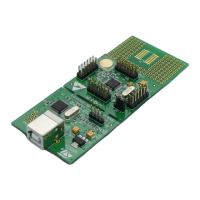RM0016 8-bit basic timer (TIM4, TIM6)
Doc ID 14587 Rev 8 249/449
19.6.7 Counter (TIMx_CNTR)
Address offset: 0x04 or 0x06 (TIM4), 0x06 (TIM6); for TIM4 address see Section 19.6.10
Reset value: 0x00
76543210
CNT[7:0]
rw rw rw rw rw
rw
rw rw
Bits 7:0 CNT[7:0]: Counter value
